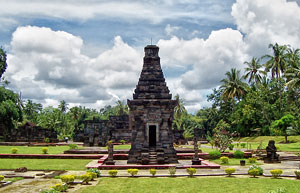Welcome to East Java
East Java is one of Indonesia provinces. It is located on the
eastern part of Java Island and near to Madura and Bawean islands. It
state in the West neighbor of Bali, across the small Strait of Bali.
East Java tourism offer attractions, from historical site like temples
to recreational spots like beaches, lakes, volcanoes, marine gardens and
wildlife reserves. Magnificent mountain sceneries, include the craters
and the famous of Mount Bromo, the "sulfur mountain" of Welirang and
rugged line Plateau. Remaining the glory of Majapahit Empire, the ruins
nowadays is still exist as an history witnesses with some archaeological
discoveries. East Java government have claim this historical site
against colonial forces since 1945

The administrative center of the province is located in
Surabaya, which is the second largest city in Indonesia after Jakarta
and as a major industrial center and business port. East Java is also
considered as a national industrial province. The economic commodity is
coming from agriculture; include of coffee, mangoes and apples, fishery
and oil industries. The transportation to go to East Java area can be
reach by public vehicle or train services. There are also air services
between Surabaya and other cities like Bali or Jakarta or some other
provinces. Madura Island, which is famous for its bull races, is part
of East Java province, though it has its own traditions and language.
The history dates back numbers of invasion in East Java like the
founding of prehistoric animals and the site of the Java man at Trinil,
Ngawi or some hidden ruin temples which settled on 7th century AD.
Where to Stay
As one of interesting tourism destination, East Java has
already equipped by some tourism accommodation to comfort the visitors
to stay longer. Almost in all East Java regencies have equipped with
complete facilities, so that the visitors feel no worries about
accommodation and everything they need. Just enjoy your holiday in East
Java and explore the tourism objects. Just stay as like your own home.
Map
Here comes the complete map of East Java. We present the map
in medium and high resolution. It also complete from all East Java
regencies.
Find here the detail of East Java tourism and get your back pack to have
a journey with our high resolution map as your personal guide.
Madura Island
Madura island is one of exotic island which is part of East
Java province. The local inhabitant is Madurese people. They have strong
temperament yet unique culture. Explore Madura Island and see the
exotic one. They have many things to remember, like, the annual ceremony
of karapan sapi, their particular batik Madura, their traditional food
and so on.
The Legend of Majapahit
In 14th century, East Java was part of the biggest and the
most powerful Kingdom in Southeast Asia named Majapahit kingdom.
Nowadays, the relic of Majapahit Kingdom is still exist remaining the
history itself, and it lies on East Java. Enjoy the ruin of history by
looking for temples, statues, remarkable residents, ancient tools and
many things about Majapahit Kingdom. Visit now!

